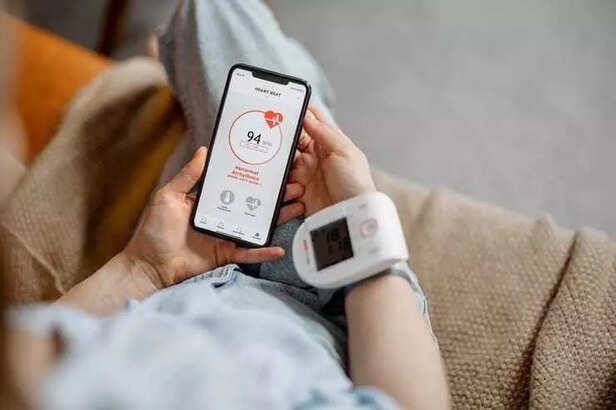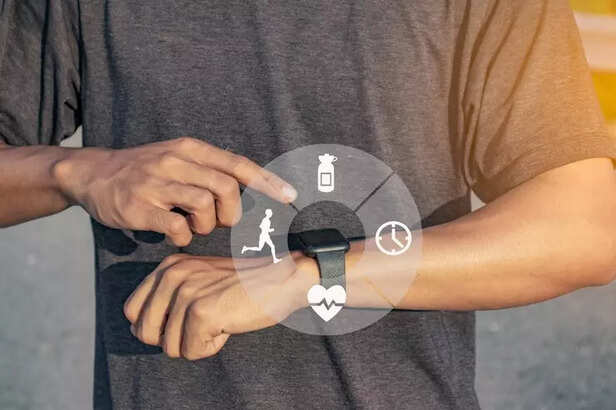From Steps to Symptoms: Wearable Devices Are Transforming Healthcare
Prem Kamde | Mon, 12 May 2025
Wearable devices have evolved from simple step counters to sophisticated health monitoring tools that detect symptoms, track chronic conditions, and provide real-time insights. This shift marks a revolutionary era in personal healthcare, where data-driven decisions and preventive care are powered by smart technology. From heart rate monitors and sleep trackers to blood glucose sensors and ECG-enabled wearables, the integration of these devices into daily life is reshaping how we approach wellness, early diagnosis, and medical intervention. As wearable health tech continues to advance, it's not just improving lives—it's saving them.
( Image credit : Freepik )
Photo:
Wearable technology has come a long way from counting steps and tracking calories. What once began as a simple tool for fitness enthusiasts has now evolved into an essential element in personal healthcare. Today, wearable devices do more than just monitor physical activity—they are actively transforming the healthcare industry by offering real-time data, early diagnosis capabilities, and personalized health management.

The introduction of wearable devices marked a turning point in how individuals engage with their health. At first, devices like pedometers and basic fitness trackers served mainly to motivate users to stay active. However, advancements in technology have drastically expanded their capabilities.
Now, these devices can monitor heart rate variability, blood oxygen levels, sleep cycles, skin temperature, blood glucose, and even detect irregular heart rhythms. What makes this transformation so significant is not just the range of data collected, but how that data can be interpreted to provide real-time insights and early warnings for potential health issues.

One of the greatest impacts of wearable health tech lies in preventive care. Instead of relying solely on occasional doctor visits or lab tests, people can now monitor their bodies continuously. Wearable technology for health offers users—and in many cases, healthcare providers—a window into the body’s daily patterns.
For instance, a smartwatch that detects an irregular heartbeat can prompt a user to seek medical attention before symptoms become severe. Diabetics can now use continuous glucose monitors (CGMs) that provide constant updates on blood sugar levels, helping them avoid dangerous spikes or drops. In many cases, wearable devices have led to the early detection of conditions like atrial fibrillation, sleep apnea, and even stress-induced cardiovascular problems.

The global rise of telehealth has created a perfect environment for wearable technology to thrive. As more healthcare services move online, wearable devices act as bridges between patients and providers. Doctors can now receive updates from their patients’ devices remotely, allowing for timely interventions and more informed consultations.
This is particularly valuable for elderly patients or those with chronic illnesses who require regular monitoring. Wearable devices reduce the need for frequent hospital visits while ensuring that doctors have access to accurate, up-to-date health data.

Perhaps one of the most underrated aspects of wearable health tech is the sense of empowerment it brings to individuals. Instead of being passive recipients of healthcare, users become active participants in their own well-being. They can track progress, set goals, and identify trends in their physical and mental health over time.
By making health data accessible and understandable, wearable devices encourage people to make informed lifestyle choices. Whether it’s increasing daily activity, improving sleep hygiene, managing stress, or controlling chronic conditions, users are equipped with tools that help them take control of their health.

Despite their benefits, wearable health devices are not without challenges. Data privacy is a major concern, as sensitive health information must be securely stored and transmitted. Additionally, the accuracy of some devices varies, which can lead to false alarms or missed warnings.
There’s also the issue of accessibility. While wearable devices are becoming more affordable, high-end models with advanced features may still be out of reach for many. Ensuring that this technology is inclusive and equitable will be critical as it becomes more embedded in healthcare systems.

The future of personal health tracking devices is promising. We are already seeing the integration of artificial intelligence and machine learning into wearables, allowing for predictive analytics and personalized health recommendations. Soon, devices may be able to detect early signs of diseases like Parkinson’s or Alzheimer’s based on subtle behavioral patterns.
Additionally, collaborations between tech companies and healthcare providers are leading to FDA-approved medical-grade devices that can diagnose, monitor, and even treat certain conditions. These developments could redefine what it means to “visit the doctor,” as more care shifts from clinics to our own homes.
Wearable health technology is no longer just a trend—it’s a transformation. From tracking steps to detecting symptoms, these devices are changing how we understand, manage, and improve our health. They offer a more proactive approach to wellness, giving users the power to catch warning signs early and take action before conditions escalate.
As wearable devices continue to evolve and integrate with broader healthcare systems, their role in personal and public health will only grow stronger. The shift from reactive to proactive care is underway—and it’s happening right on our wrists.
Unlock insightful tips and inspiration on personal growth, productivity, and well-being. Stay motivated and updated with the latest at My Life XP.
A New Era in Personal Health Monitoring

A New Era in Personal Health Monitoring
( Image credit : Freepik )
The introduction of wearable devices marked a turning point in how individuals engage with their health. At first, devices like pedometers and basic fitness trackers served mainly to motivate users to stay active. However, advancements in technology have drastically expanded their capabilities.
Now, these devices can monitor heart rate variability, blood oxygen levels, sleep cycles, skin temperature, blood glucose, and even detect irregular heart rhythms. What makes this transformation so significant is not just the range of data collected, but how that data can be interpreted to provide real-time insights and early warnings for potential health issues.
Preventive Healthcare Gets Personal

Preventive Healthcare Gets Personal
( Image credit : Freepik )
One of the greatest impacts of wearable health tech lies in preventive care. Instead of relying solely on occasional doctor visits or lab tests, people can now monitor their bodies continuously. Wearable technology for health offers users—and in many cases, healthcare providers—a window into the body’s daily patterns.
For instance, a smartwatch that detects an irregular heartbeat can prompt a user to seek medical attention before symptoms become severe. Diabetics can now use continuous glucose monitors (CGMs) that provide constant updates on blood sugar levels, helping them avoid dangerous spikes or drops. In many cases, wearable devices have led to the early detection of conditions like atrial fibrillation, sleep apnea, and even stress-induced cardiovascular problems.
Remote Monitoring and Telehealth Integration

Remote Monitoring and Telehealth Integration
( Image credit : Freepik )
The global rise of telehealth has created a perfect environment for wearable technology to thrive. As more healthcare services move online, wearable devices act as bridges between patients and providers. Doctors can now receive updates from their patients’ devices remotely, allowing for timely interventions and more informed consultations.
This is particularly valuable for elderly patients or those with chronic illnesses who require regular monitoring. Wearable devices reduce the need for frequent hospital visits while ensuring that doctors have access to accurate, up-to-date health data.
Empowering the Individual

Empowering the Individual
( Image credit : Freepik )
Perhaps one of the most underrated aspects of wearable health tech is the sense of empowerment it brings to individuals. Instead of being passive recipients of healthcare, users become active participants in their own well-being. They can track progress, set goals, and identify trends in their physical and mental health over time.
By making health data accessible and understandable, wearable devices encourage people to make informed lifestyle choices. Whether it’s increasing daily activity, improving sleep hygiene, managing stress, or controlling chronic conditions, users are equipped with tools that help them take control of their health.
Challenges and Considerations

Challenges and Considerations
( Image credit : Freepik )
Despite their benefits, wearable health devices are not without challenges. Data privacy is a major concern, as sensitive health information must be securely stored and transmitted. Additionally, the accuracy of some devices varies, which can lead to false alarms or missed warnings.
There’s also the issue of accessibility. While wearable devices are becoming more affordable, high-end models with advanced features may still be out of reach for many. Ensuring that this technology is inclusive and equitable will be critical as it becomes more embedded in healthcare systems.
The Future of Wearable Health Tech

The Future of Wearable Health Tech
( Image credit : Freepik )
The future of personal health tracking devices is promising. We are already seeing the integration of artificial intelligence and machine learning into wearables, allowing for predictive analytics and personalized health recommendations. Soon, devices may be able to detect early signs of diseases like Parkinson’s or Alzheimer’s based on subtle behavioral patterns.
Additionally, collaborations between tech companies and healthcare providers are leading to FDA-approved medical-grade devices that can diagnose, monitor, and even treat certain conditions. These developments could redefine what it means to “visit the doctor,” as more care shifts from clinics to our own homes.
Wearable health technology is no longer just a trend—it’s a transformation. From tracking steps to detecting symptoms, these devices are changing how we understand, manage, and improve our health. They offer a more proactive approach to wellness, giving users the power to catch warning signs early and take action before conditions escalate.
As wearable devices continue to evolve and integrate with broader healthcare systems, their role in personal and public health will only grow stronger. The shift from reactive to proactive care is underway—and it’s happening right on our wrists.
Unlock insightful tips and inspiration on personal growth, productivity, and well-being. Stay motivated and updated with the latest at My Life XP.
Frequently asked questions (FAQs)
- How does wearable technology improve health?Wearable technology improves health by tracking vital signs, detecting early symptoms, and encouraging healthier habits through real-time feedback and personalized data.
- How will wearable medical devices transform healthcare?They will enable remote monitoring, early diagnosis, and continuous care—reducing hospital visits and personalizing treatment for chronic and acute conditions.
- What are the 4 wearable technologies?The four common types are smartwatches, fitness trackers, wearable ECG monitors, and smart clothing or patches with embedded sensors.










